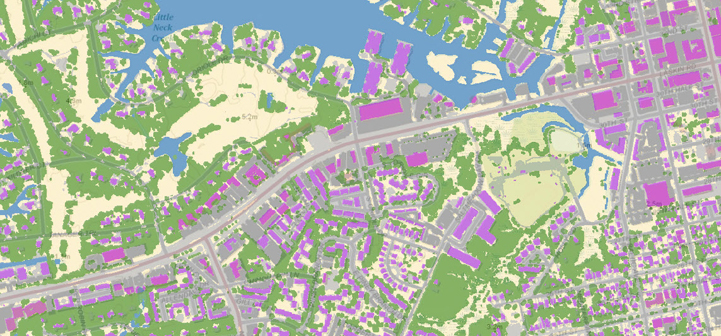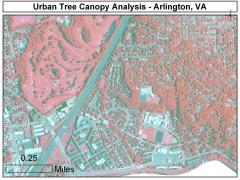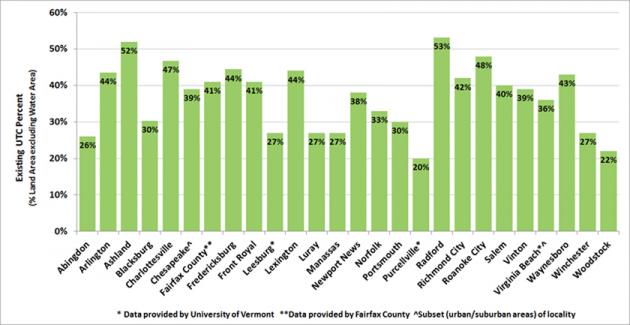
Classified tree canopy layer in the Virginia Urban Tree Canopy Mapper – http://www.utcmapper.frec.vt.edu
Urban forests can be defined as the sum of all woody and associated vegetation in and around dense human settlements (Miller 1997). The people living in and around urban forests receive many direct and indirect benefits, such as the cooling effect of strategically placed trees around a house or the reduced costs of storm-water management (Konijnendijk et al. 2005). In order to estimate the social and ecosystem service benefits being provided by an urban forest, the amount of tree canopy cover must first be calculated. This article describes a method for estimating urban tree canopy.
The Urban Tree Canopy (UTC) Project is a partnership between the Chesapeake Bay Program, the Virginia Department of Forestry (VDOF), the Virginia Geospatial Extension Program (VGEP) at Virginia Tech, and the localities participating in the project. The goal of the project is to assist partnered localities by providing them with the tools and technical infrastructure to assess UTC coverage.
Analysis Methods
Using our procedures, tree canopy cover is assessed by the following means:
- Use of one-meter (or better), four-band aerial imagery (figure 1)
- Definition of the geographical boundaries of the localities
- Classification of the landscape into four classes: tree canopy, non-tree vegetation, impervious, and water (figure 2)
- Determination of the baseline percent of canopy cover

Figure 1: Four-band, one-meter National Agriculture Imagery Program (NAIP) imagery

Figure 2: Classified NAIP imagery
Summary Methods
Land-cover data is summarized by using the UTC geospatial toolbox (in Esri ArcMap) developed by Jarlath O’Neil-Dunne at the Spatial Analysis Laboratory (SAL) at the University of Vermont. The UTC toolbox incorporates building footprints into the land-cover classification, creating a five-class land-cover that includes the following elements (figure 2):
- water
- non-building impervious surfaces
- non tree vegetation
- tree canopy
- structures
Local governments provide digitized parcel and zoning layers to project analysts.The UTC data is then summarized by parcels and zoning classifications. A report is then created containing the summarized metrics and maps (figure 3).
Other reports can be accessed from the Urban Tree Canopy website
Figure 3: UTC report from Norfolk, VA
Outcomes & Impacts
Baseline canopy cover and summaries (figures, maps, and assessment metrics) of existing tree canopy and possible tree canopy are generated for each locality. This information is provided in the form of a report, which is provided to communities. Generated spatial data is also provided to localities to further facilitate their planning and management efforts. Localities can then decide on canopy coverage goals and identify approaches to attain and sustain their goals. Project partners are available to assist in these efforts when required. The current UTC localities are illustrated in figure 4 with existing UTCs for all completed localities compared.

Figure 4: Existing UTC percentages for participating localities
Over 1,000 square miles have been analyzed through the UTC Project. This has resulted in the identification of over 420 square miles of mapped UTC. Using Fairfax County’s estimates for air pollution, energy conservation, and storm-water management benefits, 420 square miles of UTC generates approximately $6 billion annually in ecosystem service benefits.
It is anticipated that a follow-up UTC assessment will be conducted in the future. This will enable decision makers in municipalities to determine whether their urban tree canopy goals have been realized over time. Follow-up assessments will enable local governments to better fine-tune policies and approaches to maintain or increase UTC.
Currently project partners, led by the Virginia Geospatial Extension Program and faculty in the Department of Forest Resources and Environmental Conservation at Virginia Tech, are working on a UTC web-mapping application for Virginia. This will enable the public to better understand the spatial characteristics associated with their community’s green infrastructure and will provide customized spatial statistics associated with their respective communities through a custom-developed online viewing application.
Sources
-
Miller RW (1997) Urban Forestry: Planning and Managing Urban Greenspaces. 2nd edition. Prentice Hall, New Jersey. 502 pp.
-
Konijnendijk, C.C, Nilsson, K., Randrup, T.B. and Schipperijn, J. (Eds.), 2005. Urban Forests and Trees. Springer, Heidelberg.
For More Information
- More information about the Virginia Urban Tree Canopy program can be found here: http://cnre.vt.edu/gep/va_utc.html
- Additional information about Virginia Tech’s Urban Forestry program can be found here: http://urbanforestry.frec.vt.edu
- The USDA’s Urban and Community Forestry Program can be accessed here: http://www.fs.fed.us/ucf/
Contributors
Article by John McGee, Virginia Geospatial Extension Specialist

